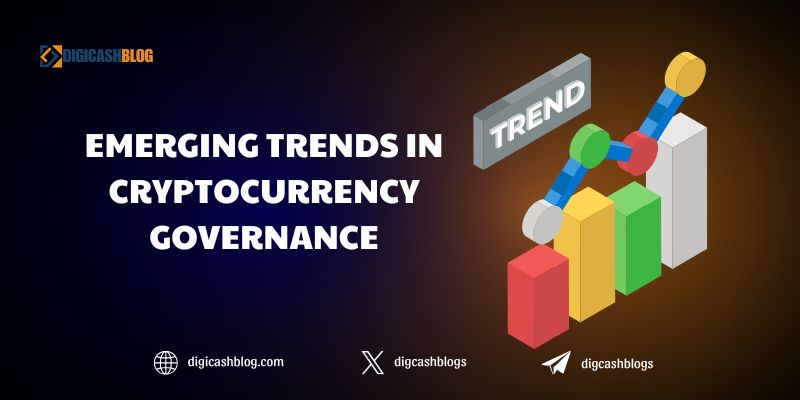Emerging Trends in Cryptocurrency Governance
Cryptocurrency governance, the framework for decision-making and protocol management in blockchain ecosystems, is evolving rapidly in 2025. Emerging trends in cryptocurrency governance are reshaping how decentralized networks operate, balancing community participation, regulatory compliance, and technological innovation. As blockchain adoption grows, governance models are critical for ensuring scalability, security, and fairness. This article explores key trends, their implications, and strategies for navigating this dynamic landscape.
Key Trends in Cryptocurrency Governance
Decentralized Autonomous Organizations (DAOs) Leading the Way
Decentralized Autonomous Organizations (DAOs) are at the forefront of cryptocurrency governance, enabling community-driven decision-making through smart contracts. In 2025, DAOs like MakerDAO and Uniswap have refined their governance models, using token-based voting to manage protocol upgrades and treasury allocations. Advanced DAOs now integrate quadratic voting and reputation systems to enhance fairness, reducing the influence of large token holders, or “whales.” This trend promotes inclusivity but faces challenges in voter apathy and scalability.
Integration of AI in Governance Processes
The convergence of artificial intelligence (AI) and governance, inspired by concepts like DeFAI, is gaining traction. AI-driven tools analyze on-chain data, predict voting outcomes, and automate routine governance tasks, such as proposal screening. Projects like Fetch.ai use AI to optimize decision-making in DeFi protocols, ensuring efficient resource allocation. This trend simplifies complex governance processes but raises concerns about transparency and over-reliance on automated systems.

Regulatory Compliance and On-Chain Governance
Global regulations, such as the EU’s Markets in Crypto-Assets (MiCA) framework, are influencing governance structures. In 2025, crypto projects are adopting on-chain compliance mechanisms, embedding KYC (Know Your Customer) and AML (Anti-Money Laundering) protocols into governance frameworks. For example, stablecoin issuers like those behind EURØP on the XRP Ledger align with MiCA to ensure regulatory adherence. This trend enhances trust but increases operational complexity for decentralized networks.
Layer-2 Governance Models
Layer-2 solutions, such as Arbitrum and Optimism, are introducing unique governance frameworks to manage scalability and transaction efficiency. These protocols use off-chain voting systems synced with layer-1 blockchains, allowing faster decision-making without compromising security. In 2025, layer-2 DAOs are emerging, enabling communities to govern scaling solutions independently. This trend supports blockchain scalability but requires coordination between layer-1 and layer-2 governance to avoid conflicts.
Community-Driven Forking and Protocol Upgrades
Community-driven forks are becoming a governance trend, allowing stakeholders to propose and implement protocol changes. Ethereum’s upgrades, like the Dencun upgrade, showcase how community consensus drives scalability improvements. However, contentious forks, as seen in historical cases like Ethereum Classic, highlight the need for robust governance to prevent fragmentation. In 2025, projects are adopting formal dispute resolution mechanisms to streamline upgrades and maintain network unity.
Implications for Blockchain Ecosystems
Enhancing Decentralization and Fairness
Emerging governance trends aim to balance decentralization with efficiency. Quadratic voting and reputation-based systems reduce the dominance of large token holders, fostering equitable participation. However, achieving true decentralization remains challenging, as low voter turnout and technical barriers persist. Projects must prioritize user education to ensure broad engagement.
Bridging Traditional and Decentralized Finance
Governance models are aligning with traditional finance through regulatory compliance and institutional participation. Banks and fintechs, like Société Générale, are engaging with DAOs to explore tokenized assets, requiring governance frameworks that accommodate both decentralized communities and regulated entities. This trend bridges DeFi and traditional finance but demands clear legal structures.
Addressing Scalability and Security
Layer-2 governance and AI integration address scalability by streamlining decision-making and reducing on-chain costs. However, security risks, such as smart contract vulnerabilities or AI biases, pose challenges. Governance protocols must incorporate regular audits and transparent reporting to maintain trust and resilience.

Challenges in Cryptocurrency Governance
Voter Apathy and Participation Gaps
Low participation in governance processes remains a hurdle. Despite token-based voting, only a small percentage of token holders engage in DAOs, as seen in Uniswap’s governance polls. Simplifying voting interfaces and offering incentives, like staking rewards, can boost participation but may introduce new risks, such as vote buying.
Regulatory and Compliance Pressures
Regulations like MiCA require governance frameworks to integrate KYC/AML checks, which can conflict with decentralization principles. Projects must balance privacy with compliance, a challenge in regions with stringent laws. The risk of regulatory fragmentation across jurisdictions further complicates global governance models.
Security and Transparency Concerns
AI-driven governance and complex smart contracts increase the risk of exploits. High-profile hacks, like those on DeFi platforms in 2023, underscore the need for robust security measures. Transparent governance, including open-source code and public voting records, is essential to maintain community trust.
Strategies for Effective Governance
Enhancing Community Engagement
Projects should leverage platforms like Discord and X to educate users about governance processes. Gamifying participation, as seen in GameFi projects like The Sandbox, can increase engagement. Clear communication of proposals and their impacts is critical to fostering active communities.
Leveraging On-Chain Analytics
Tools like Glassnode and Dune Analytics provide insights into voting patterns and token distribution, helping DAOs identify governance trends. These tools enable data-driven decisions, ensuring alignment with community priorities and market dynamics.
Building Regulatory-Compatible Frameworks
To align with regulations, projects should embed compliance into smart contracts while preserving decentralization. Collaborating with regulators, as Ripple has done with stablecoin frameworks, can create governance models that satisfy both community and legal requirements.
Future Outlook
The future of emerging trends in cryptocurrency governance lies in hybrid models that combine decentralization, AI automation, and regulatory compliance. As layer-2 solutions and tokenized assets grow, governance frameworks will need to adapt to manage cross-chain interactions and institutional involvement. Central bank digital currencies (CBDCs), like the digital euro, may influence governance by setting standards for transparency and accountability.
Emerging trends in cryptocurrency governance in 2025, including DAOs, AI integration, and regulatory alignment, are transforming blockchain ecosystems. These trends enhance decentralization and scalability but face challenges like voter apathy and security risks. By leveraging analytics, fostering engagement, and balancing compliance with decentralization, crypto projects can build robust governance models that drive innovation and trust in the evolving financial landscape.
